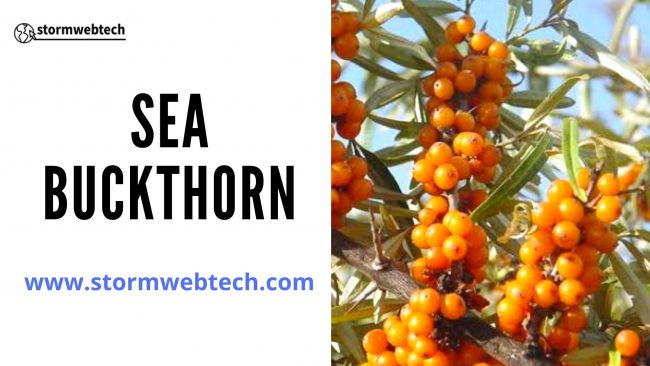Let’s know about what is sea buckthorn ?, sea buckthorn upsc, seabuckthorn gk facts, seabuckthorn in india, benefits of seabuckthorn.
Sea buckthorn, scientifically known as Hippophae rhamnoides, is a deciduous shrub that belongs to the Elaeagnaceae family. It is native to Europe and Asia and is known for its bright orange berries, which have been used for centuries for their medicinal and nutritional properties.
What is sea buckthorn ?
~ Sea buckthorn ( Hippophae rhamnoides ) is a shrub which produces an orange-yellow coloured edible berry. Seabuckthorn grows in dry, sandy areas. It is a deciduous, dioecious spinescent shrub that reaches a height of 2–4 m. The plant grows naturally in sandy soil at an altitude of 1,200-4,500 meters in cold climates, though it can be cultivated at lower altitudes and into temperate zones. It’s leaves are alternate, lanceolate, narrow and dark green with a silver-gray tone at the bottom.
Here are some key characteristics and uses of sea buckthorn :
Berries : Sea buckthorn berries are small, round, and typically orange or yellow in color. They are rich in various nutrients, including vitamins (especially vitamin C), minerals, antioxidants, and fatty acids.
Nutritional Value : Sea buckthorn berries are particularly valued for their high vitamin C content, which is even higher than that of oranges. They also contain vitamin A, vitamin E, vitamin K, and several B vitamins. Additionally, they are a source of essential fatty acids, such as omega-3 and omega-6.
Medicinal Uses : Sea buckthorn has a long history of use in traditional medicine. It is believed to have various health benefits, such as boosting the immune system, reducing inflammation, improving skin health, and promoting cardiovascular health. Some of these potential benefits are attributed to the presence of antioxidants and bioactive compounds in the berries.
Sea buckthorn’s leaves, flowers, seeds and fruits are used to make medicine. Seabuckthorn oil is extracted from the berries and seeds of the seabuckthorn plant, and both the berries and seeds are great for the skin and provide internal benefits. Sea buckthorn has been widely used for treating stomach, heart and skin problems. It’s fruit and leaves are rich in vitamins, carotenoids and omega fatty acids.
Culinary Uses : While the berries have a tart and somewhat astringent taste, they can be used in culinary applications. They are sometimes used to make juices, jams, jellies, and sauces. Additionally, sea buckthorn oil, extracted from the berries, is used as a dietary supplement.
Cosmetic and Skincare Products : Seabuckthorn oil and extracts are commonly used in cosmetics and skincare products due to their potential benefits for the skin. They are used in creams, lotions, and serums for their moisturizing and anti-aging properties.
Seabuckthorn also has commercial value, as it is used in making juices, jams, nutritional capsules etc. Sea buckthorn is also used in the manufacturing of cosmetics and anti-ageing products.
Environmental Benefits : Sea buckthorn is considered a nitrogen-fixing plant, which means it can improve soil fertility by converting atmospheric nitrogen into a form that plants can use. It can also provide habitat and food for wildlife. Sea buckthorn is an important source of fuelwood and fodder.
This Plant has an extensive root system which can fix atmospheric nitrogen, that helps in controlling soil erosion and preventing desertification. The sea buckthorn plant’s extensive root system makes it useful for stabilizing sandy soils and preventing erosion, particularly in coastal areas. So, seabuckthorn is a soil-binding plant which prevents soil-erosion, checks siltation in rivers and helps preserve floral biodiversity.
Seabuckthorn In India : In India, it is found above the tree line in the Himalayan region, generally in dry areas such as the cold deserts of Ladakh and Spiti. Seabuckthorn is also called as Leh Berries, Ladakh Gold and Wonder Plant. In Himachal Pradesh, it is locally called chharma and grows in the wild in Lahaul and Spiti and parts of Kinnaur. In the Lahaul valley, where willow trees are dying in large numbers due to pest attack, this hardy shrub is a good alternative for protecting the local ecology.
According to the Seabuckthorn Association of India, around 15,000 hectares in Himachal, Ladakh, Uttarakhand, Sikkim and Arunachal Pradesh are covered by this plant.
It’s worth noting that while sea buckthorn is generally considered safe when consumed in moderation, excessive consumption of the berries or their products can lead to digestive discomfort due to their high acidity. As with any supplement or natural remedy, it’s advisable to consult with a healthcare professional before using sea buckthorn for medicinal purposes, especially if you have underlying health conditions or are taking medications.
Read More -:
- What is Acid Rain
- What Is RSV
- What Is Aspartame
- What is Blue Flag Certification
- What Is Earth Hour
- What Is Credit Card
- What is A Computer Virus
- What is Guillain-Barré Syndrome
- What Is Gresham’s Law In Economics
- What Is Brand Reputation Management
- Coursera Free Courses With Certificates
Please Follow Us -: Pinterest
